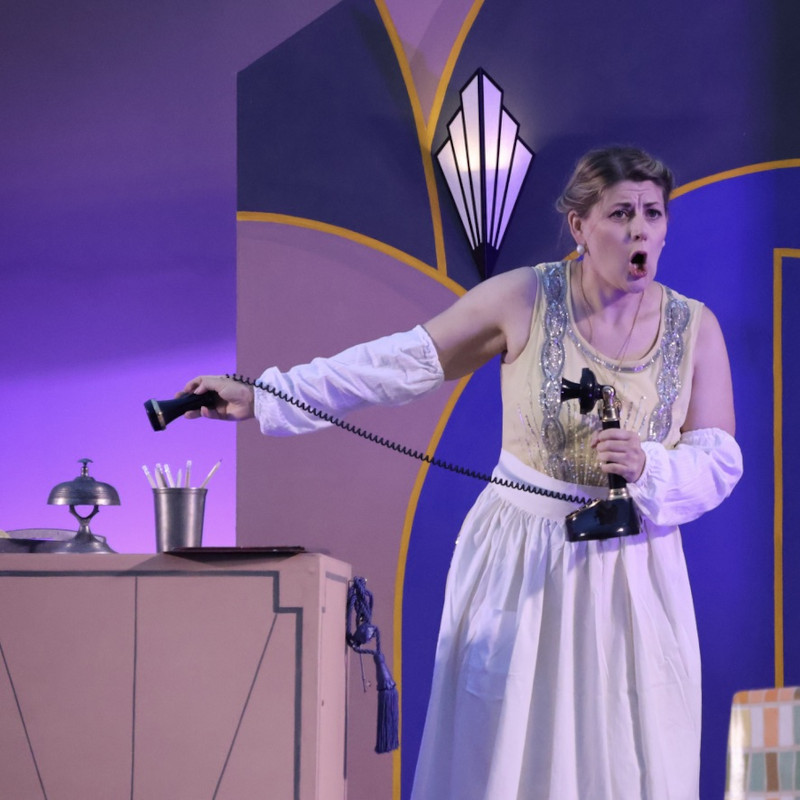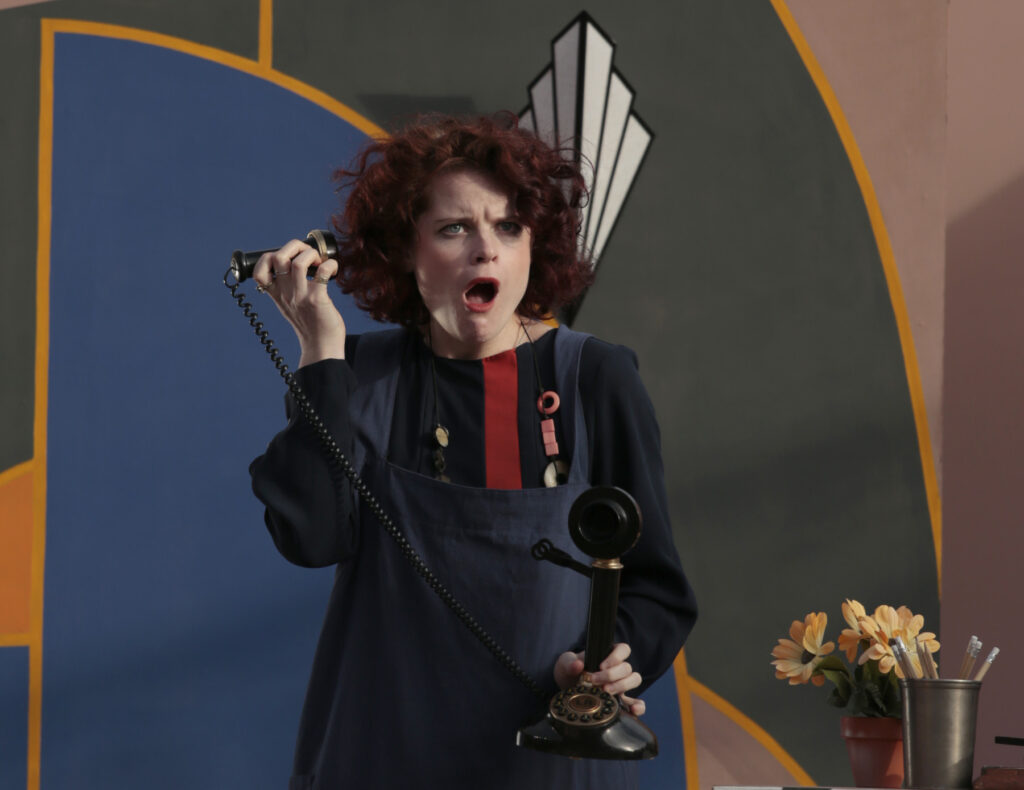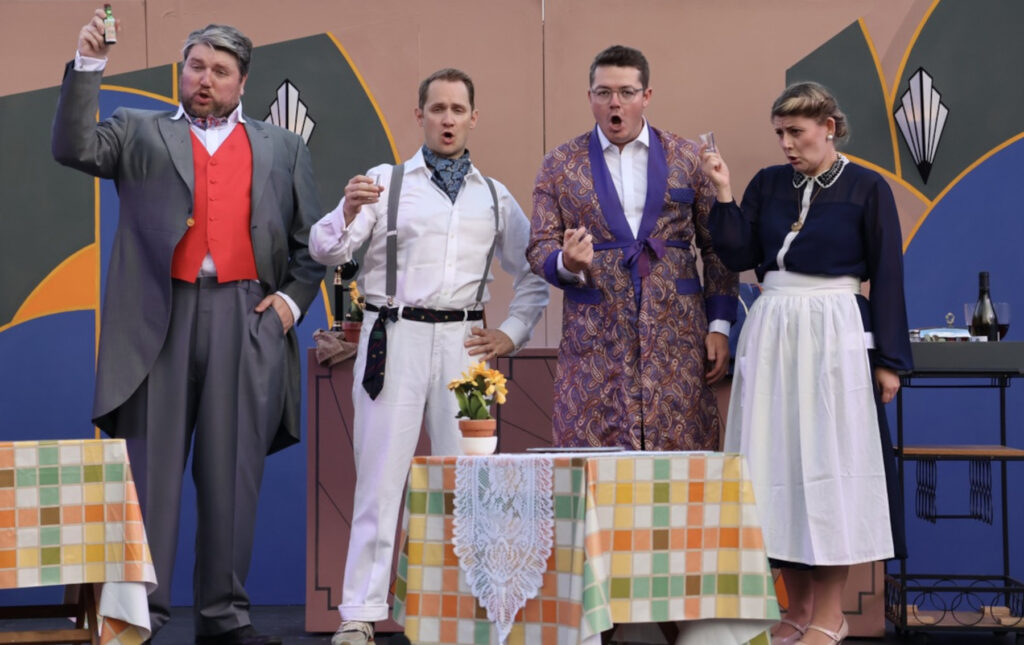For those familiar with Peter Shaffer’s Amadeus film, it was Salieri who had the last laugh. He outlived Mozart by 34 years, not dying until 1825, so this year marks the 200th anniversary of his death. Bampton Classical Opera has made it a point of interest to stage a number of his operas and tour them to various venues, and this year it was the turn of La locandiera (The Landlady), premiered at Vienna’s Burgtheater in June 1773. This is based on a play by Carlo Goldoni which, in the name of the heroine Mirandolina, also served as the inspiration for a later opera by Martinů. Salieri’s drama giocoso is essentially a battle of the sexes dressed up as a comedy of manners. As the landlady of a Florentine inn, Mirandolina charms and then outwits three aristocratic guests in residence there, The Baron Ripafratta, The Count of Albafiorita and The Marquis of Forlimpopoli, before finally yielding to her loyal yet jealous servant Fabrizio.

At the end of Shaffer’s film, Salieri proclaims: “I speak for all mediocrities in the world. I am their champion. I am their patron saint.” As a final judgement on his music, this is patently unfair. Yes, the modest instrumentation here of two horns, two oboes and a bassoon together with strings often results in a monochromatic palette of sound, with cadences a little too obvious and predictable. The progression from one arioso to the next, with passages of recitative accompanied by a harpsichord, occasionally strengthened by strings, is formalistic; the ear waits in vain for melodies that resonate beyond their lines; the absence of fully worked out vocal ensembles means the music never really moves out of third gear. However, the piece is unfailingly genial and bubbles along with touches of exhilaration; the vocal writing includes coloratura elements; though there are next to no orchestral highlights, the voices are sensibly supported and never overwhelmed, thanks also to the judicious pacing of the Chroma musicians under Andrew Griffiths. The English translation by Gilly French and Jeremy Gray makes a structural feature of rhymes (vanity/sanity; crazy/hazy; fashion/passion) and also has many an example of wry humour. At one stage Mirandolina imparts “My anchovy sauce is famous” (later she concocts an appetising apple crumble and custard); the Marquis deploys hyperbole to advance his cause (“I am like a firework”); the Baron acknowledges his propensity for ampoules and vials (“Hypochondria is more my style”). Towards the end of Act 1, Fabrizio arrives with an array of eggs in ever-increasing sizes, in an attempt to placate the boorish Baron. In fact, this production is never boring and offers an evening of wholesome and unalloyed fun.

The action has been transferred from the late 18th century to the inter-war years, with Art Deco styling very much in evidence in two paravents, wall lighting and even in a set of fresh bedlinen. Apart from a free-standing sign advertising “Stanze Disponibili” (= Rooms available), later switched round to reveal “Locanda al completo” (= The inn is full), and checked tablecloths in the colours of the national flag, there is nothing overtly Italian. I appreciated the attention paid to period detail: the candlestick design of the telephone, the spray bottle from which Mirandolina dispenses perfume, the Clarice Cliff teapot and cups; the boaters and tennis whites worn by the aristocrats, complete with sporting accoutrements such as tennis rackets, golf clubs and croquet mallets. The costumes too by Pauline Smith and Anne Baldwin are very much in keeping with the time: the bejewelled cloche hat worn by the maid Lena, for instance; the sapphire-blue waistcoat and frock coat which the Baron sports; the long string of pearls and necklace with bold geometric designs which adorn the two ladies. Just two things felt out of place: the Baron’s very modern-looking eyewear and all the hairstyles. Fabrizio’s skin-fade and full beard were not characteristic of waiters in the 1920s.
Having already given earlier performances elsewhere, the cast demonstrated how bedded in they were with their roles. Siân Dicker’s Mirandolina is the forthright and often feisty landlady, anxious to please and receptive to the charms of her three male aristocratic guests, but in no hurry to settle down. She is suitably ingratiating when required: in her cavatina with the Baron, “This is the first time I’ve had the pleasure of shaking hands with a man of honour”, she is all feminine. At other times she can be haughtily dismissive, as in her Act 2 exchanges with Fabrizio, “Fabrizio, love, you’re going all doolally”. Vocally strong and secure in the coloratura writing, she acts convincingly throughout, from early simpering gestures to her Act 2 fainting fit, and not least her in touching duet with Fabrizio during the final act when she admits to the depth of feelings she has for him. As Lena, who shares the opening scene with Fabrizio, Rosalind Dobson sings a bright and lively character, albeit with touches of shrillness in her aria “Love can be jealous, breeding suspicion”. She, after all, has her own designs on Fabrizio. Her hands and fingers are the embodiment of expressiveness.

All four men are strongly characterised. There is a certain busyness to the production, most evident in the physically agile Fabrizio’s constant entrances and exits, yet Samuel Pantcheff’s warm and virile baritone soon swings support in his favour. He tries so hard to impress his mistress but is repeatedly rebuffed. The growing jealousy he feels at having to witness her perpetual flirtatiousness with the three aristocrats reaches its apogee in his folksong-like aria “Mirandolina, I can endure no longer”. It is Osian Wyn Bowen who in the role of the Baron demonstrates the most obvious degree of character development. The most formally dressed of the three, initially he gives off a very studious air, not interested in matters of the flesh, and inescapably misogynistic towards Mirandolina (“merely a woman like any other”), he gradually succumbs to her charms, writing her a cryptic letter and finding himself overwhelmed by his growing feelings for her, expressed in his Act 2 cavatina “In confusion I am seeing I have lost my sense of being), and taking an impish delight in the discovery of a book on the art of kissing. Outer composure gives way to the intense fury of his Act 3 aria “Cruel, ungrateful woman, at first you dare seduce me”, when he realises he has been used all along. His increasing ardour finds full expression in his warm tenor voice, matched by excellent clarity of diction.
Aidan Edwards plays his Marquis as a Falstaffian kind of character, overbearing in manner, with a winning range of smiles and facial expressions, replete with a good line in falsetto, such as when he picks up the phone and sings “Mirandolina, come to me, I love you, yes I do”, his red waistcoat merely underlining his unquenchable self-confidence, his rounded bass register adding extra weight. David Horton sings a self-important Count, eager to make a favourable impression by gifting Mirandolina an expensive pendant on her birthday. He has a great time in Act 2 indulging his penchant for gin, making much of his florid lines in the aria “When in love with a fount of beauty”, and adding to the many touches of humour in this production by proffering his bottle of spirit to the conductor before exiting the stage.
What I find very striking about this opera is the subversive commentary about the relationship between the servant classes and their social superiors, well over a decade before Mozart was to put this centre-stage in The Marriage of Figaro. As if to underline the connection, Fabrizio sings an interpolated snatch in Italian from Figaro to demonstrate his utter disdain for the Baron. The realisation of the potential for humorous entertainment in La locandiera, together with a fastidious sense of direction and, above all, the use of young but already distinctive voices, is an example of what small companies like Bampton Classical Opera can do so effectively. Now, with a solid record of showcasing rarities from the late 18th century over the past 32 years, it is to be hoped that Bampton’s energies will continue to remain undimmed.
Alexander Hall
La locandiera (The Landlady)
Opera in three acts with a libretto by Domenico Poggi, based on a play by Carlo Goldoni, in a translation by Gilly French and Jeremy Gray
A Bampton Classical Opera production sung in English
Music by Antonio Salieri, in an arrangement by Giorgio Croci
Cast and production staff:
Mirandolina – Siân Dicker; Fabrizio – Samuel Pantcheff; Lena – Rosalind Dobson; The Baron Ripafratta – Osian Wyn Bowen; The Count of Albafiorita – David Horton; The Marquis of Forlimpopoli – Aidan Edwards
Musicians of Chroma – conductor Andrew Griffiths
Director and Designer – Jeremy Gray; Movement Director – Karen Halliday; Costumes – Pauline Smith and Anne Baldwin; Lighting – Ian Chandler; Assistant Director – Harriet Cameron; Répétiteur – Alex Norton
Smith Square Hall, London, 16 September 2025
Top image: Samuel Pantcheff (Fabrizio)
All photos © Bampton Classical Opera